Chapter 1: Providing the Right Support
Updated 30 July 2021
Applies to England, Scotland and Wales
This is a summary of analysis to support Chapter 1 of Shaping Future Support: The Health and Disability Green Paper. The publication covers information on working age health and disability benefits in Great Britain.
This includes:
- The number of people receiving working age health and disability benefits over time
- The number of people receiving different combinations of benefits in November 2020
- Where people claiming PIP receive help
- Details of people receiving the Mobility component of Disability Living Allowance (DLA) and Personal Independence Payment (PIP)
What you need to know
The data in this evidence pack comes from a range of sources that are referenced in the accompanying data tables. The new data presented here includes analysis from:
- 100% DWP administrative data of people receiving:
- Employment and Support Allowance (ESA)
- Universal Credit (UC)
- DLA
- PIP
- 100% DWP administrative data of Work Capability Assessments and PIP assessments, mandatory reconsiderations (MRs) and appeals
- 100% DWP administrative data of people attending employment programmes
- 100% HMRC administrative data of P14 and P45 records of people receiving DWP benefits.
- DWP Benefit Caseload and Expenditure Outturn and Forecasts
- DWP commissioned research reports
- 0ther research reports
- survey data
Data tables, which provide more details on the data and analysis presented here, are available online.
1. Main stories
The statistics show:
- DWP provides a range of support to large numbers of disabled people, including UC and PIP
- The number of disabled people receiving both ESA/UC* and PIP/DLA is increasing
- Many people can use the benefit system or already have help, but others do not
- There are 2.5m people with specific mobility needs, and some are supported by the Motability scheme
2. DWP provides a range of financial support to record numbers of disabled people, including UC and PIP
The number of people receiving a working age income replacement health and disability benefit from 1992 to 2020

Sources: Benefit Expenditure and Caseload tables and Shaping Future Support Green Paper evidence pack
Approximately 2.5m people receive a working age income replacement health and disability benefit because they are unable to work owing to a health condition or disability.
Employment and Support Allowance (ESA) offers financial support to help with living costs if you are unable to work because of a health condition or disability.
There are two types of ESA. One is means-tested and is for people with no or low income. This is gradually being replaced with Universal Credit. The other type is based upon national insurance contributions and therefore does not take into account any savings a person (or their partner) may have. This ‘new style’ ESA is not being replaced by Universal Credit and a person can continue to receive both together if they qualify for both.
Universal Credit (UC) offers financial support to help with your living costs. You may be eligible if you are on a low income, out of work or you cannot work.
The number of working age people receiving ESA, UC*, or previous income replacement health benefits reached a peak of 2.8m in 2003 to 2004 and was declining until 2019 to 2020 when the number of people receiving these benefits began to rise.
The number of working age people receiving an extra costs health and disability benefit from 1992 to 2020
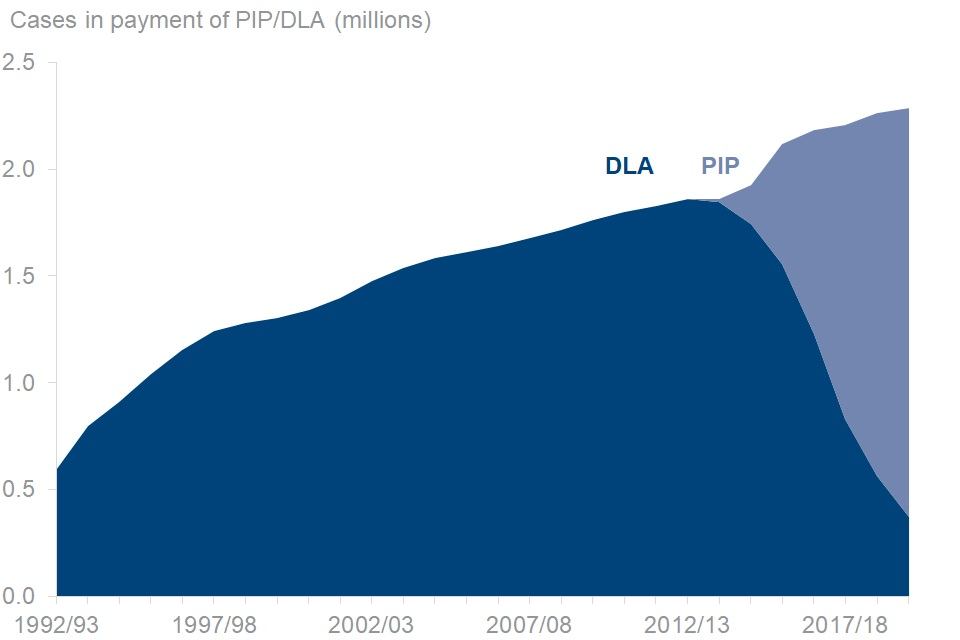
Source: Benefit Expenditure and Caseload tables
The number of people receiving PIP or DLA to help with some of the costs of their disability has been increasing for the last 30 years.
Personal Independence Payment (PIP) offers financial support to help with some of the extra costs if you have a long term health condition or disability. PIP was introduced in 2013 to replace Disability Living Allowance (DLA) for working age adults.
Since 1992 the number of working age people receiving PIP or DLA has increased from 0.6 million people to 2.3m million people in 2019/20.
3. The number of disabled people receiving both ESA/UC and PIP/DLA is increasing
The number of people receiving only ESA/UC* or only PIP/DLA, or both, November 2020
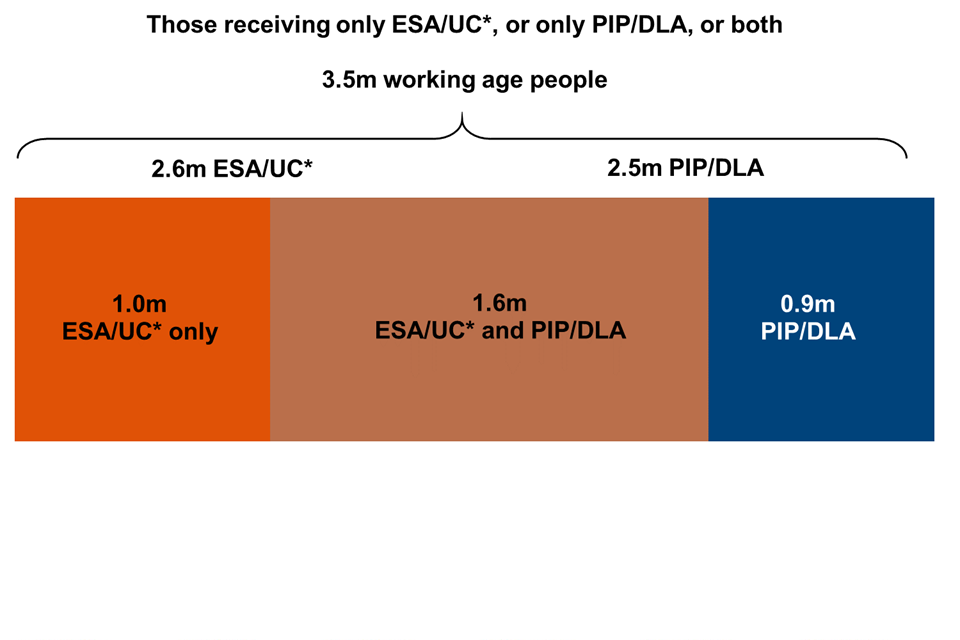
Source: Shaping Future Support Green Paper evidence pack
Around 2 in 3 people who receive ESA/UC* also receive PIP/DLA, and around 2 in 3 people who receive PIP/DLA also receive ESA/UC*
There were a total of 3.5m working age people receiving one of ESA/UC* or PIP/DLA in November 2020. 1.6m of these receive both benefits. In 2013, there were 3.0m working age people receiving one of these benefits. Of these only 1.3m received both.
Take-up of benefits can be affected by multiple factors. Trying to explain the reasons for non-take-up is difficult and DWP does not have data to do this. Take-up may be affected by broad factors such as the attractiveness of the benefit, awareness of the benefit/application procedure, awareness of entitlement, and the perceived stigma of receiving a benefit.
PIP/DLA can help with some of the extra costs if your health condition or disability is expected to last 12 months, while ESA/UC* can provide financial support to people whose disability or health condition affects how much they can work. Receiving one benefit does not mean an individual will be eligible for the other.
Whether people who receive only ESA/UC*, or only PIP/DLA, have ever received the other benefit

Source: Shaping Future Support Green Paper evidence pack
Around half of those receiving only one benefit may have previously received or tried to claim the other benefit.
413,000 people who receive only PIP/DLA have previously received an income-replacement benefit, namely ESA or UC* (or a similar historical benefit such as IB or SDA). This is 49% of people receiving only PIP/DLA.
384,000 people who receive only ESA or UC* have previously made a claim for PIP or received DLA, including 6,000 people who made a claim to PIP and withdrew their application.
Some of these may have previously been receiving DLA as a child. This is 40% of people receiving only ESA/UC*.
79% of people who receive only ESA or UC* and who have previously made a claim for PIP were disallowed. In most cases (291,000 cases), this is because they were disallowed following their assessment, while in other cases they did not complete the process.
4. Many people can use the benefit system or already have help, others do not
Where people claiming PIP first heard about PIP
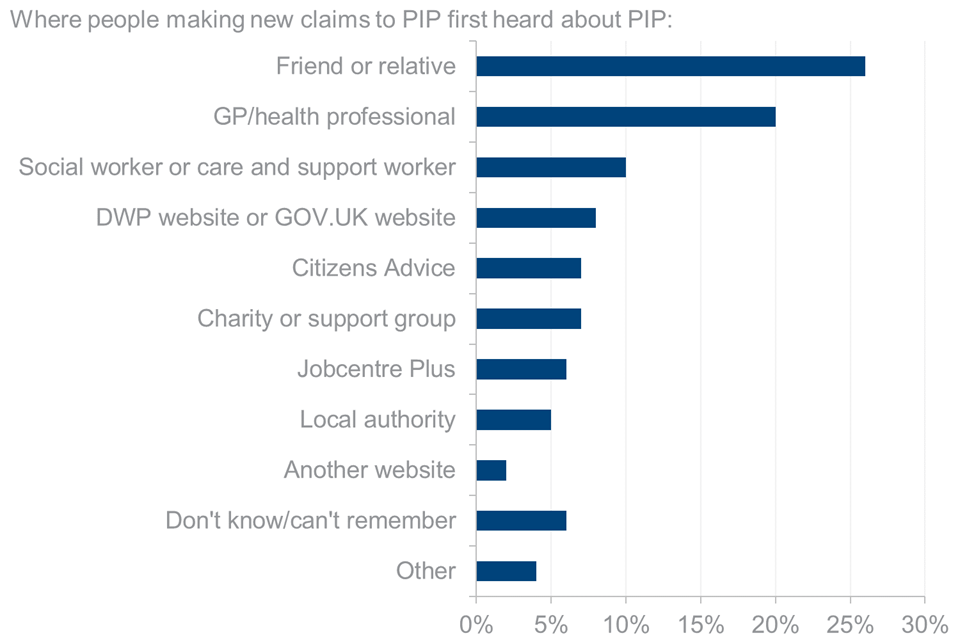
Source: PIP Claimant Research
People find out about extra-cost benefits most commonly from friends or relatives.
In a survey of people making new claims to PIP as part of the PIP Claimant Research, people were asked how they first heard about PIP.
26% of people who were making new claims first heard about PIP from a friend or relative, which was the most common source of help. 20% of people first heard about PIP from a GP or health professional, and 10% from a social worker or care and support worker.
More than one response could be given, meaning the person could have heard about PIP from more than one source.
Sources of help when completing the PIP application form
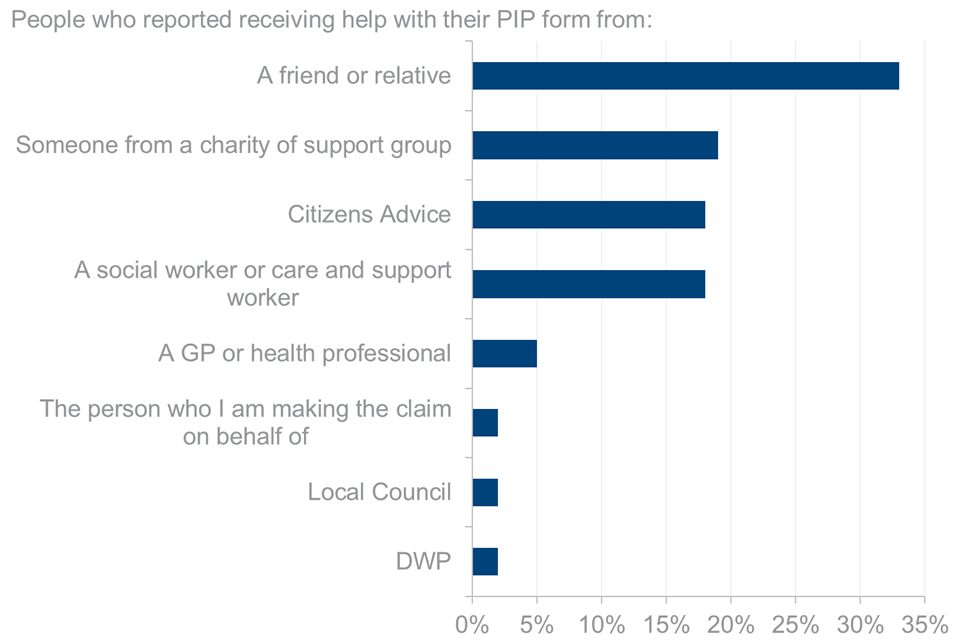
Source: PIP Claimant Research
Friends and relatives are also the most common sources of help when completing forms.
In the same survey as part of the PIP Claimant Research, people were asked who they sought or would seek help from when completing the PIP application form.
33% of people received help from a friend or relative when completing the PIP application form, which was the most common source of help. 19% received help from someone from a charity or support group, and 18% received help from a social worker or care and support worker. 18% received help from Citizens Advice.
More than one response could be given, meaning the person could have received help from more than one source.
5. There are 2.5m people with specific mobility needs, and some are supported by the Motability scheme
The proportion of people receiving PIP/DLA mobility component
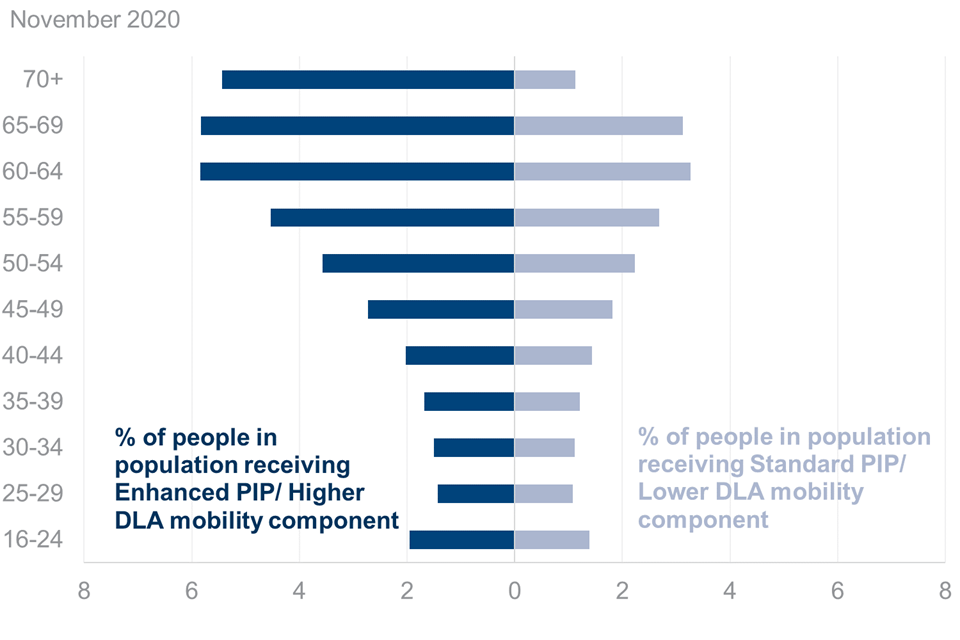
Sources: The ONS, People, Population and Community and Stat-Xplore
The proportion of people receiving the PIP or DLA mobility component increases with age.
Disabled people may get the mobility part of PIP or DLA if they need help going out or moving around.
As people get older, they are generally more likely to receive the PIP or DLA mobility component. However, a smaller proportion of people aged over 70 receive the PIP or DLA mobility component than people aged 55 to 69.
DLA is now closed to new claims from adults, and it is not possible to claim PIP once you pass the state pension age, although awards will continue if held to the next assessment.
People eligible for Motability compared to those claiming it
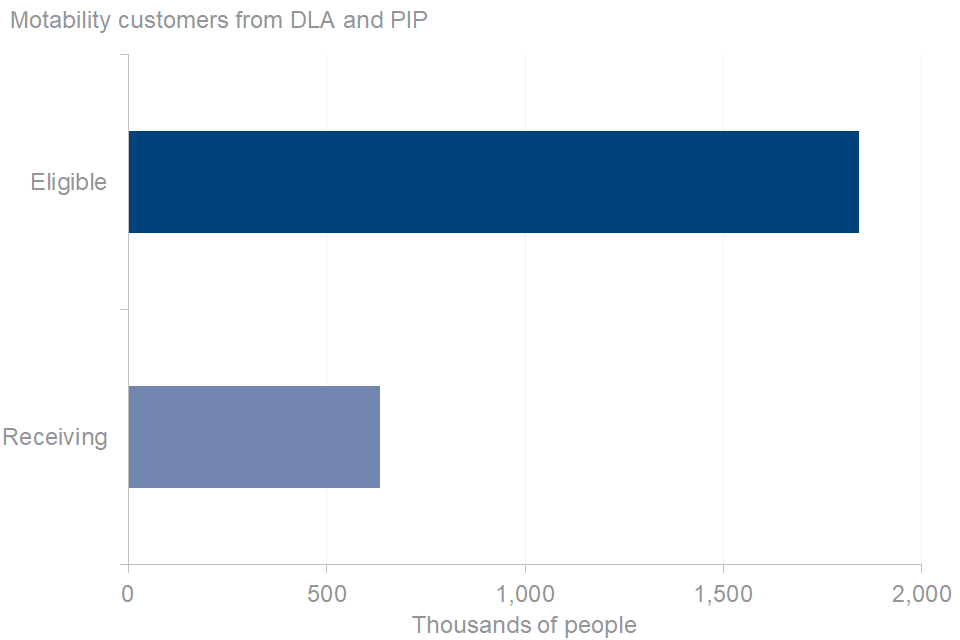
Sources: Motability Annual Report 2020 and Stat-Xplore
1.8 million people are eligible for the Motability Scheme including those from PIP, DLA and other benefits, of which 34% take it up.
The Motability Scheme is available to disabled people who receive the Higher Rate Mobility Component of Disability Living Allowance (DLA), Enhanced Rate Mobility Component of Personal Independence Payment (PIP), War Pensioners’ Mobility Supplement (WPMS) or Armed Forces Independence Payment (AFIP).
The Motability Scheme provides access to a wide choice of mobility solutions for disabled people. The charity currently offers grants towards vehicle adaptations, vehicle advance payments (a one-off payment that covers the difference between the higher rate mobility allowance and the total cost of a lease), and driving lessons.
6. Important terms and abbreviations
Terms and abbreviations used throughout this publication
Caseload
The number of people receiving a benefit.
Claim
A request for a benefit.
Disabled people
People with a disability or long-term health condition.
DLA
Disability Living Allowance, which is being replaced by PIP and helps with the extra costs associated with long-term ill-health or a disability.
ESA
Employment and Support Allowance, which people can apply for if they have long-term ill-health or disability that affects their ability to work.
IS
Income Support, which is extra money to help people on a low income or none. You can no longer make a new claim for Income Support. If you’re on a low income and need help to cover your living costs, you can apply for Universal Credit instead.
JCP
Jobcentre Plus, which provide services to some people who require financial assistance.
JSA
Jobseeker’s Allowance, which is an unemployment benefit people can claim while they look for work.
LCW
Limited Capability for Work, a group on UC where you are not expected to look for work right away.
LCWRA
Limited Capability for Work and Related Activity, a group on UC you are not expected to look for work or to prepare for work.
PIP
Personal Independence Payment, which can help people with some of the extra costs associated with long-term ill-health or a disability.
PSP
Personal Support Package, which offers tailored support for people in the ESA WRAG or Universal Credit LCW group.
SG
Support Group, a group on ESA for people who are assessed as not able to get back into work.
SRTI
Special Rules for Terminal Illness, if a person is living with a terminal illness and a doctor or a medical professional has said they might have less than 6 months to live, they may get benefits at a higher rate or get extra money and start getting payments quicker than usual.
TI
Terminal Illness, a health condition that a person will most likely die from.
UC
Universal Credit, which is a payment to help with living costs. It is replacing 6 other benefits. These are:
- Child Tax Credit
- Housing Benefit
- Income Support
- income-based Jobseeker’s Allowance (JSA)
- income-related Employment and Support Allowance (ESA)
- Working Tax Credit
UC*
People on Universal Credit (UC) who have had medical evidence checked as they have a restricted ability to work, or are assessed as LCW or LCWRA.
WCA
Work Capability Assessment, a functional assessment of a person’s fitness to work.
WHP
Work and Health Programme, personal support to help people find and keep a job if they are out of work.
WRAG
Work Related Activity Group, a group on ESA for people who are assessed as able to get back into work in the future.
Definition of medical conditions
ICD Group refers to the World Health Organisations’ International Classification of Diseases (ICD) (2010) Condition Groups. These are sometimes referred to as medical conditions in DWP statistics. For reporting purposes, the conditions as recorded on DWP systems have been mapped to reflect as closely as possible the appropriate ICD10 code. Conditions are based on evidence provided and may not represent a person’s most recent medical condition. Where someone has more than one diagnosis or disabling condition, only the predominant one is reported on in these statistics.
Definition of medical conditions
ICD Group refers to the World Health Organisations’ International Classification of Diseases (2010) Condition Groups. These are sometimes referred to as medical conditions in DWP statistics. For reporting purposes, the conditions as recorded on DWP systems have been mapped to reflect as closely as possible the appropriate ICD10 code. Conditions are based on evidence provided and may not represent a person’s most recent medical condition. Where someone has more than one diagnosis or disabling condition, only the predominant one is reported on in these statistics.
The following abbreviations are used in these statistics.
| Abbreviation used in these statistics | ICD10 Description |
|---|---|
| Infectious Diseases | Certain Infectious and Parasitic Diseases (A00 - B99) |
| Neoplasms | Neoplasms (C00 - D48) |
| Blood/Immune System Diseases | Diseases of the Blood and Blood forming organs and certain diseases involving the immune mechanism (D50 - D89) |
| Metabolic Diseases | Endocrine, Nutritional and Metabolic Diseases (E00 - E90) |
| Mental/Behavioural Disorders | Mental and Behavioural Disorders (F00 - F99) |
| Nervous System Diseases | Diseases of the Nervous System (G00 - G99) |
| Visual Impairment | Diseases of the Eye and Adnexa (H00 - H59) |
| Hearing Impairment | Diseases of the Ear and Mastoid Process (H60 - H95) |
| Circulatory Diseases | Diseases of the Circulatory System (I00 - I99) |
| Respiratory Diseases | Diseases of the Respiratory System (J00 - J99) |
| Digestive Diseases | Diseases of the Digestive System (K00 - K93) |
| Skin Diseases | Diseases of the Skin and Subcutaneous System (L00 - L99) |
| Musculoskeletal Diseases | Diseases of the Musculoskeletal system and Connective Tissue (M00 - M99) |
| Genitourinary Diseases | Diseases of the Genitourinary System (N00 - N99) |
| Pregnancy | Pregnancy, Childbirth and the Puerperium (O00 - O99) |
| Perinatal conditions | Certain conditions originating in the perinatal period (P00-P96) |
| Congenital conditions | Congenital Malformations, Deformations and Chromosomal Abnormalities (Q00 - Q99) |
| Not classified elsewhere | Symptoms, Signs and Abnormal Clinical and Laboratory findings, not elsewhere classified (R00 - R99) |
| External causes | Injury, Poisoning and certain other consequences of external causes (S00 - T98) |
| External causes | External causes of morbidity and mortality (V01-Y98) |
| Health Services | Factors influencing health status and contact with health services (Z00 - Z99) |
| Unknown | Unknown or person without diagnosis on the system |
